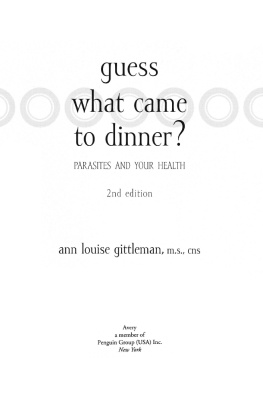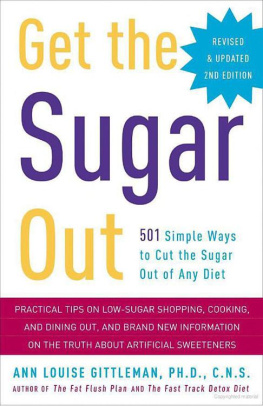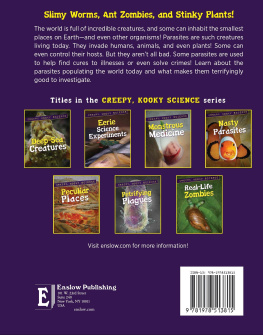reprinted with permission from The Medical Letter.
Every effort has been made to ensure that the information contained in this book is complete and accurate. However, neither the publisher nor the author is engaged in rendering professional advice or services to the individual reader. The ideas, procedures, and suggestions contained in this book are not intended as a substitute for consulting with your physician. All matters regarding health require medical supervision. Neither the author nor the publisher shall be liable or responsible for any loss, injury, or damage allegedly arising from any information or suggestion in this book.
Most Avery books are available at special quantity discounts for bulk purchase for sales promotions, premiums, fund-raising, and educational needs. Special books or book excerpts also can be created to fit specific needs. For details, write Penguin Group (USA) Inc. Special Markets, 375 Hudson Street, New York, NY 10014.

a member of
Penguin Group (USA) Inc.
375 Hudson Street
New York, NY 10014
www.penguin.com
Copyright 1993, 2001 by Ann Louise Gittleman, M.S., CNS
All rights reserved. This book, or parts thereof, may not be reproduced in any form without permission.
Published simultaneously in Canada
Library of Congress Cataloging-in-Publication Data
Gittleman, Ann Louise.
Guess what came to dinner? : parasites and your health / Ann Louise
Gittleman.Rev. and updated ed.
p. cm.
Includes bibliographical references and index.
ebook ISBN 978-1-101-66249-6
1. Parasitic diseasesPopular works. I. Title.
RC119.G58 2001 00-069517
616.96dc21
acknowledgments
I truly must thank my beloved mentors for their pioneering work in the arena of parasitology. My most sincere thanks to Dr. LuCrece Dowell, Dr. Hermann Bueno, Dr. Louis Parrish, Dr. Leo Litter, Dr. Peter Weina, Dr. Hazel Parcells, Dr. Robert Bradford, and Dr. Omar Amin. I am also grateful for the contributions made by Reverend Hanna Kroeger, Dr. Fred Houston, Dr. Bernard Jensen, Ann Wigmore, Dr. Stuart Russell, Linda Hooper, and Herbert Shapiro. I especially want to thank the entire Schoor family, especially Michael, William, and Jo Len, for their total health vision. I would also be remiss if I did not thank Lyle Hurd and Roon Frost, who have always been huge supporters of my message.
Both Ann Castro and Stuart K. Gittleman provided invaluable assistance for this updated version of Guess What Came to Dinner? Alice Q. Swanson assisted me single-handedly with the original manuscript and I will forever be grateful for her diligence, compassion, and integrity. Alice is simply the best.
And of course I would like to acknowledge everyone at Penguin Putnam and Avery, especially Laura Shepherd and Christopher Mariadason, for their invaluable editorial assistance.
Most of all I would like to acknowledge you, my readers, whose letters, e-mails, and phone calls have made my research into the world of parasites a most fulfilling and worthwhile venture.
foreword
A s a professor of parasitology, founder of the Parasitology Center, and an international authority in the field with over 130 major publications and books on parasitology, I have not come across a book like Ann Louise Gittlemans Guess What Came to Dinner? It is the first published work that brought good science to the public in a user-friendly way. I was impressed upon my first reading of this book with how the subject of parasitic infections and diseases, not quite a dinner-table conversation topic, gracefully addressed both laymens and practitioners concerns.
Most significantly the book brought to the publics attention the importance of parasites and how they impact human health. If you think that, in the United States, we are safe from such third-world infections, then you are greatly misinformed. Some estimate that about 50 million American children are infected with worm parasites, only a small portion of which are detected and reported. This is particularly worrisome when one recognizes that microscopic, single-celled protozoans make up about 90 percent of all parasitic infections in the U.S. according to the Centers for Disease Control and Prevention (CDC). If existing parasitic infections are evenly distributed, there would be more than enough parasites for every living person to have one.
For one book, Guess What Came to Dinner?, to pioneer the effort to educate the public about such a problem is quite an accomplishment. Parasite infections can and do compromise our immune systems and digestive tracts, as well as all other organ systems. They can cause chronic fatigue, leaky gut syndrome, dysbiosis (imbalance of the intestinal bacteria), irritable bowel syndrome, fibromyalgia (sleep disorder), ulcerative colitis, allergies, toxicities, and many others. The point is, the situation is not improving.
Contributions like those of Ann Louise Gittleman are indispensable in order to manage this serious threat to our health. Her book includes sections on symptoms, types of parasites, how we contract parasitic infections, diagnosis, treatment, and prevention. I find the table of Warning Signs to be particularly useful and comprehensive. This second edition is especially valuable as it is updated and has incorporated many new and key research findings in practically all sections of the book. As a result, some changes and rearrangements were made that produced a very readable and informative version.
I must state that Guess What Came to Dinner? contributes considerably more to the publics understanding and awareness of the parasitic problem than many published hard-core scientific publications. It also provides a practical guide to how to deal with the problem both to the laymen and the practitioner.
Dr. Omar M. Amin, Ph.D.
preface
W hen I first wrote Guess What Came to Dinner? back in 1993, many people found the whole idea of parasites living inside a human host, well, quite shocking to say the least. Thankfully today, however, the general public has come to realize the cold, hard fact: Parasites are not only alive and well but thriving among (and in) a good sector of the American population. Parasites invade our homes, workplaces, day-care centers, restaurants, produce aisles, water resources, pets, and just about any other place we eat, sleep, or play. Some of them are pathogenic; all of them destroy our health and well-being. And the chilling truth is, parasitic infections are continually on the rise. Perhaps never before has it been more crucial for each of us to take action than right now.
Which is why I felt compelled to update this book. Recognizing the imminent need to empower people in the fight against parasitic infections, Ive set out to enlighten readers with the latest findings. As I shared in the first edition, there are definite steps we must all take to eradicate the parasitic problem in our country. That hasnt changed. It begins with education and more definitive methods of detection, followed by specific, nutritionally supportive modes of treatment. And, of course, we also must gain savvy in our preventative process. This revision is designed to help you do all of that. Youll discover new information on various parasite species; breakthrough methods of detection, such as the stool antigen test; the most recent listing of antiparasitic drugs and treatment dosages from The Medical Letter; the latest herbal cures; as well as more helpful additions to the prevention tips.













